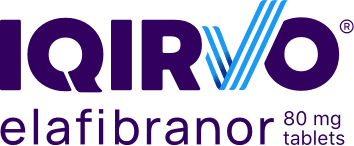Safety & tolerability
Safety and tolerability established in the ELATIVE® trial1
Common adverse reactions occurring in the ELATIVE trial1,a
|
Adverse reactionb |
UDCA alone |
IQIRVO + UDCA |
|---|---|---|
|
Weight gainc |
21% (11) |
23% (25) |
|
Diarrhea |
9% (5) |
11% (12) |
|
Abdominal painc |
6% (3) |
11% (12) |
|
Nausea |
6% (3) |
11% (12) |
|
Vomiting |
2% (1) |
11% (12) |
|
Arthralgia |
4% (2) |
8% (9) |
|
Constipation |
2% (1) |
8% (9) |
|
Muscle painc |
2% (1) |
7% (8) |
|
Fracturec |
0 |
6% (7) |
|
Gastroesophageal reflux disease |
2% (1) |
6% (7) |
|
Dry mouth |
2% (1) |
5% (5) |
|
Weight loss |
0 |
5% (5) |
|
Rashc |
4% (2) |
5% (5) |
No new safety signals in OLE2
97% of patients who completed ELATIVE rolled over into the open-label extension2,3
No new safety signals were identified in the 3-year OLE trial2
Most common treatment-emergent adverse events in the OLE trial were abdominal pain, diarrhea, nausea, and vomiting2
Adverse events leading to study discontinuation in the ELATIVE trial were similar between the IQIRVO (10%) and UDCA-alone (9%) groups3
In a post hoc analysis, bone mineral density, biomarkers of bone turnover, and frequency of bone fractures were assessed in patients receiving IQIRVO and UDCA alone.
Baseline characteristics assessments revealed that greater proportions of patients on IQIRVO had a medical history of osteopenia and osteoporosis compared to those on UDCA alone.
LS mean changes from baseline in BMD T-scores
by region at week 52
LS mean changes from baseline in CTX and P1NP at week 52
Seven patients receiving IQIRVO had bone fractures, of whom 6 patients had an associated accidental fall resulting in fractures consistent with those typically experienced by patients with PBC; all patients had a confounding medical history. No patients receiving UDCA alone had bone fractures.
In an analysis of renal health in patients in the ELATIVE trial, eGFR was calculated over 52 weeks as a measure of renal function.2
Median eGFR was similar between patients receiving IQIRVO and UDCA alone and remained stable through week 52.2
IQIRVO has no impact on renal function and does not require dose adjustment for renal impairment.1
No new safety signals in OLE2
97% of patients who completed ELATIVE rolled over into the open-label extension2,3
No new safety signals were identified in the 3-year OLE trial2
Most common treatment-emergent adverse events in the OLE trial were abdominal pain, diarrhea, nausea, and vomiting2
Adverse events leading to study discontinuation in the ELATIVE trial were similar between the IQIRVO (10%) and UDCA-alone (9%) groups3
Set expectations for your patients about possible side effects and that
there may be an adjustment period when starting IQIRVO1,2
GI symptoms with IQIRVO are typically mild to moderate and resolve within the first 15 days1,2
aIncluded 8 patients (5%) who were intolerant to UDCA and initiated treatment as monotherapy: 6 patients (5%) in the IQIRVO arm and 2 patients (4%) in the placebo arm.1
bOccurring in greater than or equal to 5% of patients in the IQIRVO treatment arm and at an incidence greater than or equal to 1% higher than in the placebo treatment arm.1
cWeight gain, abdominal pain, muscle pain, fracture, and rash include other related terms.1
BMD=bone mineral density; CfB=change from baseline; CI=confidence interval; CTX=carboxy terminal crosslinked telopeptides of type 1 collagen; eGFR=estimated glomerular filtration rate; GI=gastrointestinal; LS=least squares; OLE=open-label extension; P1NP=type 1 procollagen peptide; UDCA=ursodeoxycholic acid.
References: 1. IQIRVO [package insert]. Ipsen Biopharmaceuticals, Inc. Cambridge, MA. 2. Data on file. Ipsen Biopharmaceuticals, Inc. 3. Kowdley KV, Bowlus CL, Levy C, et al; ELATIVE Study Investigators’ Group. Efficacy and safety of elafibranor in primary biliary cholangitis. N Engl J Med. 2024;390(9):795-805, suppl.

